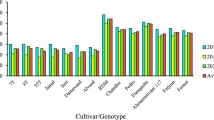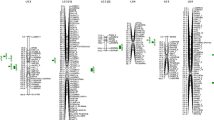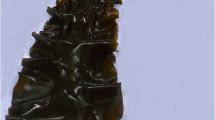Abstract
To construct a molecular-marker-assisted selection (MAS) system, research was done on identifying molecular markers linking to longer frond length, a crucial selection index in the breeding of the commercially important seaweed Saccharina japonica. An F2-segregant population of 92 individuals was obtained by crossing two prominent S. japonica strains. Genomic DNA from ten individuals with the longest frond and ten individuals with the shortest frond in the F2-segregant population were mixed to create two DNA pools for screening polymorphic markers. In bulked-segregant analysis (BSA), out of 100 random amplified polymorphic DNA (RAPD) primers only two produced three polymorphic RAPD markers between the two DNA pools. In conversion of the three RAPD markers into sequence-characterized amplified region (SCAR) markers, only one was successfully converted into a SCAR marker FL-569 linking to the trait of longer frond. Test of the marker FL-569 showed that 80% of the individuals with longest fronds in a wild population and 87.5% of individuals with the longest fronds in an inbred line “Zhongke No. 2” could be detected by FL-569. Additionally, genetic linkage analysis showed that the SCAR marker could be integrated into the reported genetic map and QTL mapping showed that FL-569 linking to qL1-1. The obtained marker FL-569 will be beneficial to MAS in S. japonica breeding.
Similar content being viewed by others
Avoid common mistakes on your manuscript.
Introduction
Saccharina japonica (Areschoug) Lane, Mayes, Druehl et Saunders used as food and raw material for algin, mannitol and iodine extraction is one of the most important commercial seaweeds in China (Tseng 1983). In order to obtain excellent strains for cultivation and processing, many genetic studies have been conducted with the aim of improving the kelp quality and quantity (Zemke-White and Ohno 1999; Feng et al. 2005). Based on the results of these studies a number of improved varieties have been obtained and applied widely in cultivation promoting the development of the kelp industry (Zhang et al. 2001; Li et al. 2007a, 2008).
Many traits related to commercial value of the kelp, such as stipe length, frond length, frond width, frond thickness, and iodine content, are quantitative characteristics (Fang and Jiang 1963). These traits are controlled polygenic and susceptible to environmental changes (Wang 1984). Selection for these traits in traditional breeding program is of low efficiency as phenotypes do not accurately reflect the genotype. Marker-assisted selection (MAS) where selection is based on genotype greatly improves the efficiency of conventional selection and breeding. Selection based on genotype requires molecular markers that are tightly linking to objective traits (Mohan et al. 1997), so identification of markers linking to genes or qualitative trait loci (QTL) that control kelp economic traits is of great significance. Sequence-characterized amplified region (SCAR) marker FRML-494 relating to S. japonica female gametophytes was previously reported by Liu et al. (2009). However, there is no known report of a marker that relates to commercial traits of L. japonica.
Frond length (FL) is a crucial trait to kelp production and usually selected as a selection index in breeding program. Hence, in the present study, we selected FL as objective trait and identified markers closely related to the genes or QTL controlling the objective trait. Our aim was to identify markers potentially applied in the S. japonica MAS which can increase the selection efficiency during the breeding process.
Materials and methods
Two isolated Saccharina japonica gametophytes preserved in the Institute of Oceanology, Chinese Academy of Sciences served as parent strains. Characteristic maternal “broad and thin blade” and paternal “long and narrow blade” strains were crossed to form an F1 generation that was self-crossed to obtain an F2 segregating population. The process was carried out according to reports of Li et al. (2007b). Frond length data is described in Liu et al. (2010).
One wild S. japonica population of 60 individuals and one inbred “Zhongke No. 2” population of 24 individuals sampled randomly from cultivation areas were used to test the effectiveness of markers linking to the frond length trait. The inbred “Zhongke No. 2” population is an excellent variety exhibiting prominent character in longer frond. Both populations were collected from Rongcheng Bay, Shandong Province.
Bulked-segregant analysis
Sporophytic genomic DNA was extracted with a Plant Genomic DNA Kit (Tiangen Biotech Co., Ltd, Beijing, China) according to the manufacturer instructions. Among the F2-segregating population with 22 individuals, genomic DNA from ten individuals with the longest FL was bulked to generate a long-frond DNA pool (LF). DNA from ten individuals with the shortest FL was bulked to generate a short-frond DNA pool (SF). DNA pools were analyzed using a random amplified polymorphic DNA (RAPD) marker system to screen polymorphic loci between the DNA pools. One hundred random 10-mer primers (Sangon, Shanghai, China) were applied in RAPD analysis according to the method reported by Wang et al. (2004).
Development of SCAR marker
Through the bulked-segregant analysis, polymorphic RAPD markers between the two DNA pools were screened and checked carefully. All polymorphic bands were excised, purified by agarose gel DNA fragment recovery kit (TaKaRa, Tokyo, Japan), cloned into PMD-18T vector (TaKaRa, Tokyo, Japan), and sequenced (Sangon, Shanghai, China). Based on sequence information obtained, a pair of oligonucleotides designed using Primer Premier 5.0 (http://www.premierbiosoft.com) was used as SCAR primers for each locus. Polymerase chain reaction (PCR) amplification was carried out in 20-μL mixture consisting of 0.5 U Taq DNA polymerase (MBI), 1× PCR buffer, 0.2 mM dNTP mix, 0.6 μM of each primer pairs, 2.0 mM MgCl2, and about 50–100 ng template DNA. PCR conditions were 94°C for 4 min, followed by 35 cycles of DNA amplification (94°C, 45 s; 55°C, 1 min; 72°C, 1 min) and a final incubation at 72°C for 10 min. Polymorphic bands between the two DNA pools that were amplified by the oligonucleotide pair were regarded as being SCAR marker links to the FL trait. PCR products were electrophoresed on 1.2% agarose at a constant voltage of 4 V cm−1 for 1 h. Amplified products were visualized under UV after staining with ethidium bromide.
SCAR markers test and linkage analysis
To verify the efficiency of the obtained SCAR markers linking to the longer frond trait, primer pairs that produced the SCAR marker were used to amplify wild kelp individuals and inbred “Zhongke No. 2” individuals.
Data of genotyping of the mapping population based on the obtained SCAR marker was integrated with the other genetic mapping data previously obtained (Liu et al. 2009a) to conduct genetic linkage analysis and QTL mapping. Genetic linkage analysis and QTL mapping were performed using MAPMAKER/exp (Lander et al. 1987) and Windows QTL Cartographer 2.0 (Wang et al. 2003). A genetic linkage map was drawn using MapChart (Voorips 2002). The method and parameter settings for software corresponded with the report of Liu et al. (2010).
Results
The F2-segregant population used as mapping population and phenotypic data analysis of frond length have been described (Liu et al. 2010). The wild kelp population sampled on May 4, 2009 was not mature, even though cultured kelp was mature and in harvest stage. Frond length of the wild kelp varied from 41 cm to 196 cm and averaged 87.3 cm. The Shapiro–Wilkes' test shows that frond length variation in the wild population corresponds to normal distribution.
For RAPD analysis, two DNA pools were prepared by bulking equal amounts of genomic DNA taken from ten individuals with the longest FL and 10 individuals with the shortest FL. One hundred random 10-mer primers (Sangon, Shanghai, China) were applied to identify polymorphic loci between the two kelp DNA pools. No amplification was observed with nine primers; the other 91 primers showed amplicons ranging from 0.3 to 2.5 kb (Table 1). Eighty-nine of these 91 primers produced monomorphic amplicons while only two primers produced three reproducible polymorphic loci between the two DNA bulks (Fig. 1). These polymorphic amplicons were consistently observed in replicate testes. Based on the RAPD primer code and amplicon size, the three loci were named S22-1600, S22-550, and S42-700.
To develop the SCAR markers, the three polymorphic bands were excised, purified, cloned into the PMD-18T vector, sequenced and submitted to the NCBI database (Table 2). Homology searches with the three sequences as query sequences did not reveal significant homologies to the known sequences in the database from NCBI.
Given the instability of RAPD markers and based on information provided by the three sequences, three pairs of forward and reverse primers were designed as SCAR primers for PCR amplification (Table 2). Optimization of the PCR reaction system and condition showed that SCAR primers of loci S22-1600 and S42-700 could not exhibit replicable polymorphism between the two kelp DNA pools. The SCAR primer for locus S22-500 yielded the polymorphic amplicon with the length of 569 bp, that is the RAPD marker S22-500 was successfully converted into a SCAR marker named FL-569.
To verify the reproducibility and efficiency of SCAR marker FL-569, genomic DNA from ten individuals having the longest fronds and ten individuals having the shortest fronds selected from a wild population of 60 individuals were taken as templates to conduct PCR with SCAR marker FL-569 primers. Eight out ten individuals with longest frond could produce the objective band, while only two individuals with shortest frond could produce the objective band (Fig. 2). So 80% of the longest individuals could be detected by the SCAR marker FL-569 with a low false-positive rate of 20%. To the inbred line “Zhongke No. 2”, 21 out 24 (87.5%) individuals could yield the objective band (Fig. 3).
Genetic linkage analysis showed that the SCAR marker FL-569 could be integrated into the reported linkage group, and QTL mapping showed that FL-569 was linked to the qL1-1 (13.6 cM), which is the major QTL controlling the objective trait FL (Fig. 4; Liu et al. 2009, 2010).
Discussion
High-yield variety is the most important breeding objective to S. japonica. The correlation coefficients of the FL trait and the fresh- and dry weight are high, indicating that the frond length is crucial to the kelp yield (Wang 1984). Traditional statistical genetics studies showed that the frond length was typical quantitative traits (Fang and Jiang 1963; Fang et al. 1965) and that the interaction between the minor genes and the environment effects regulated the developmental patterns of the complex trait. Previous reports mainly focused on environmental effects and some genetic parameters on population level (Fang and Jiang 1963; Fang et al. 1965; Wang 1984). To elucidate the heredity and variation mechanism of this trait on the DNA level, the first three QTLs which could explain 42.4% of the phenotype variation were mapping (Liu et al. 2010). Here, SCAR marker FL-569 linking to the longer frond was obtained and can be used in MAS to increase the efficiency of the selection on frond length.
Near-isogenic lines (NIL) analysis and bulked-segregant analysis (BSA) are common method used to quickly identify markers linking to objective genes or traits. NIL is time-consuming and laborious because population construction requires many generation backcrosses. BSA can be performed immediately for any locus or genomic region once the segregant population has been constructed (Michelmore et al. 1991). No NIL was developed for annual S. japonica reproduction because of time and cost considerations. In our study, the F2 segregation population was obtained easily in 2 years of self-crossing, and then three polymorphic RAPD markers between the two DNA pools were identified according to the BSA method. To obtain markers that are much more highly reproducible, one of the three RAPD markers was converted into a SCAR marker. SCAR marker FL-569 is superior to a RAPD marker insofar as the SCAR marker detects only a single locus and amplification is less sensitive to reaction conditions (Paran and Michelmore 1993).
Genetic linkage analysis and QTL mapping proved that the SCAR marker FL-569 could be integrates into the reported linkage group and linked to the qL1-1 (the distance between the marker and the QTL is 13.6 cM) which is the major QTL controlling the FL trait. In the verification of efficiency, FL-569 could check out the 80% and 87.5% individuals with longest fronds in a wild population and “Zhongke No. 2” inbred line, respectively. Therefore, it can conclude that the marker FL-569 links to the long FL trait and has a much higher stability and efficiency as a marker in selection of kelp with longer frond. To further characterize this marker, the amplified band of marker FL-569 was cloned and sequenced. BLAST search of the obtaining sequence did not reveal significant homology to any known sequence in the database. There are two possible reasons to this result: (1) there are very few known sequences of S. japonica included in the database; (2) since kelp is a lower plant, its gene sequences has a low degree of similarity with the gene sequences of higher organisms.
In conclusion, a SCAR marker linking to the longer frond of kelp was successfully identified. This SCAR marker shows promise in identifying longer frond S. japonica and can increase the efficiency of kelp breeding. Future research could focus on identification more markers linked to FL trait closer and construction of MAS to promote the development of the breeding program of S. japonica.
References
Fang TC, Jiang BY (1963) Inheritance of frond length in Laminaria japonica Aresch. Oceanol Limnol Sinica 5(2):172–182
Fang TC, Jiang BY, Li JJ (1965) Further studies of the genetics of Laminaria frond-length. Oceanol Limnol Sinica 7(1):59–66
Feng L, Tang XX, Zhang PY (2005) The advancement on breeding and seed-rearing technology in kelp. Sci Tech Engng 5(8):491–495, in Chinese with English abstract
Lander ES, Green P, Abrahamson J, Barlow A, Daley MJ, Lincoln SE, Newburg L (1987) MAPMAKER: an interactive computer package for constructing primary genetic linkage maps of experimental and natural populations. Genomics 1:174–181
Li XJ, Cong YZ, Yang GP, Shi YY, Qu SC, Li ZL, Wang GW, Zhang ZZ, Luo SJ, Dai HL, Xie JZ, Jiang GL, Liu JL, Wang TY (2007a) Trait evaluation and trial cultivation of Dongfang No. 2, the hybrid of a male gametophyte clone of Laminaria longissima (Laminariales, Phaeophyta) and a female one of L. japonica. J Appl Phycol 19:139–151
Li YH, Yang YX, Liu JD, Wang XL, Gao TX, Duan DL (2007b) Genetic mapping of Laminaria japonica and L. longissima using amplified fragment length polymorphism markers in a “two-way pseudo-testcross” strategy. J Integr Plant Biol 49:392–400
Li XJ, Liu JL, Cong YZ, Qu SC, Zhang ZZ, Dai HL, Luo SJ, Han XB, Huang SS, Wang QY, Liang GJ, Sun J, Jin Y, Wang DQ, Yang GP (2008) Breeding and trial cultivation of Dongfang No. 3, a hybrid of Laminaria gametophyte clones with a more than intraspecific but less than interspecific. Aquaculture 280:76–80
Liu YS, Li LH, Wu WK, Zhou ZG (2009) A SCAR molecular marker specifically related to the female gametophytes of Saccharina (Laminaria) japonica (Phaeophyta). J Phycol 45:894–897
Liu FL, Shao ZR, Zhang HN, Liu JD, Wang XL, Duan DL (2010) QTL mapping for frond length and width in Laminaria japonica Aresch (Laminarales, Phaeophyta) using AFLP and SSR markers. Mar Biotechnol 12:386–394
Michelmore RW, Paran I, Kesseli RV (1991) Identification of markers linked to disease-resistance genes by bulked segregant analysis: a rapid method to detect markers in specific genomic regions by using segregating populations. Proc Natl Acad Sci USA 88:9828–9832
Mohan M, Nair S, Bhagwat A, Krishna TG, Yano M, Bhatia CR, Sasaki T (1997) Genome mapping, molecular markers and marker-assisted selection in crop plants. Mol Breed 3:87–103
Paran I, Michelmore RW (1993) Development of reliable PCR-based markers linked to downy mildew resistance gene in lettuce. Theor Appl Genet 85:985–993
Tseng CK (1983) Common seaweeds of China. Science, Beijing, p 204
Voorips RE (2002) MapChart: software for the graphical presentation of linkage maps and QTLs. J Hered 93:77–78
Wang QY (1984) A study of the heritability and genotypic correlation of some economic characters of L. japonica Aresch. J Shangdong Coll Oceanol 14:65–76
Wang SC, Basten CJ, Zeng ZB (2003) Program in statistical genetics. North Carolina State University, Raleigh WinqtlCart Version 2.0
Wang XL, Yang YX, Cong YZ, Duan DL (2004) DNA fingerprinting of selected Laminaria (Phaeophta) gametophytes by RAPD markers. Aquaculture 238:143–153
Zemke-White WL, Ohno M (1999) World seaweed utilization: an end-of-century summary. J Appl Phycol 11:369–376
Zhang QS, Liu SP, Qu SC, Tian ZP, Guo ZM, Cong YZ, Li ZL (2001) Studies on rearing new variety of kelp “901”. Trans Oceanol Limnol 2:46–53 (in Chinese with English abstract)
Acknowledgements
The authors thank the anonymous reviewers for insightful criticisms and comments on an earlier version of this manuscript. This research was funded by Knowledge Innovation program (KSCXZ-YW-N-47-02) of Chinese Academy of Sciences, Shandong Agricultural Seed Stock Breeding Project and Modern Agricultural industry Technology Research Project (200903030) granted to D. L. Duan.
Author information
Authors and Affiliations
Corresponding author
Rights and permissions
About this article
Cite this article
Liu, F., Yao, J., Wang, X. et al. Identification of SCAR marker linking to longer frond length of Saccharina japonica (Laminariales, Phaeophyta) using bulked-segregant analysis. J Appl Phycol 23, 709–713 (2011). https://doi.org/10.1007/s10811-010-9567-x
Received:
Revised:
Accepted:
Published:
Issue Date:
DOI: https://doi.org/10.1007/s10811-010-9567-x








